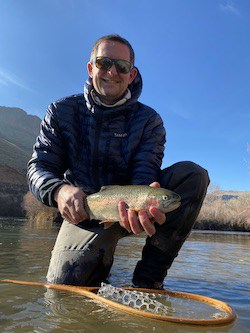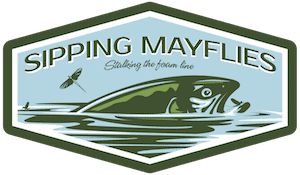DO TROUT EAT MINNOWS?
June 19th, 2022
Trout are opportunistic feeders, but their diet is always entirely carnivorous. They never consume plant matter at any stage of life.
As you can imagine, minnows are everpresent in rivers, streams, ponds, and lakes around the world, and trout avidly hunt them. In fact, minnows are one of the primary foods for most trout species.
Despite their ephemeral nature, minnows don’t generally spawn until they’re around three years old, and some species can live for over 15 years.

I’m not sure if it’s mildly embarrassing, or impressive, but this is a minnow I caught while fishing for trout. It took one of my dry flies at the surface. This species is hunted and eaten by trout throughout their range.
Do Trout Eat Minnows and Fish?
Yes, trout eat minnows and other small fish species such as sculpins, dace, and shiners. Minnows are defined as small fish that tend to swim in shoals, and as such trout hunt and consume them in shallow water where these small fish congregate.
A minnow isn’t simply a baby fish. Largemouth bass fry, or rainbow trout fry, aren’t considered minnows despite their tiny size. Instead, they’re gamefish.
Some species of fish are considered minnows their entire lifespan, such as shiners, dace, and some chubs. These fish are preyed upon by many different species of fish, not just trout.
Rainbow trout (Oncorhynchus mykiss), brown trout (Salmo trutta), cutthroat trout (Oncorhynchus clarkii), brook trout (Salvelinus fontinalis), and bull trout (Salvelinus confluentus) have many recurved teeth (including some on their tongue) which are used to subdue and kill smaller fish.
Here’s a picture I took showing the recurved teeth inside a brown trout’s mouth. These teeth are perfect for catching and holding smaller prey animals.

Which Minnows do Trout Eat?
The minnows most often associated with trout waters are dace and shiners. They attain an adult length of a few inches, and you’ll generally find them swimming in schools. Sometimes the schools are dense, and sometimes they’re sparse, but they’re always near other minnows.
The main minnow family is called cyprinidae.
The most commonly seen minnows that trout eat include the red-side shiner (Richardsonius balteatus), the redbelly dace (Chrosomus eos), the longnose dace (Rhinichthys cataractae), the creek chub (Semotilus atromaculatus), and the northern pikeminnow (Ptychocheilus oregonensis).
Most of these minnows remain small, but some get much larger. In fact, both the common carp and the grass carp are in the minnow family. But, that’s what I call a taxonomic technicality. No one considers these giant fish “minnows.”
Below is a picture of a redside shiner that I caught in a river while targeting brown and rainbow trout.

Where Do Trout Eat Minnows?
Minnows have very specific environmental requirements. They are primarily found in shallow water, and water that has little to no current.
In a river, you won’t find many minnows in deep water, because they prefer the ample cover the shallows provide. They also cannot expend energy fighting against a current, so they always prefer slack water areas.
I often see big trout chasing minnows (or even juvenile trout) and it’s always in the shallow water.
In the below video, I was tracking a huge school of minnow fry. At least 10,000 of them. This gives you a good idea of where they like to hang out (shallow and still water).
Minnows as Live Bait for Trout
If you’re fishing for trout, minnows can be a very productive live bait. Trout are naturally drawn to struggling or injured minnows, which they can sense from a distance using their lateral line.
In fact, I once listened to a podcast featuring fishing legend Kelly Galloup. He said that brown trout in a river can sense an injured minnow that is 100 yards upstream from them.
If you do use minnows as live bait, please make sure you’re not dumping them into the water after you’re done. Minnows can be invasive, and can also spread disease.
Fathead minnows (Pimephales promelas) are best, as they are slow and easily consumed by trout and other predatory fish.
Summary
Minnows are a natural food relished by trout around the world. Some say minnows and other small fish make up 10% of an average trout’s diet, but I think it’s probably a higher number than that based upon my experience.
Whether you’re using an artificial lure or a fly pattern, a minnow imitation can be super effective on monster trout. I say this because, generally speaking, trout don’t become piscivorous (fish-eating) until they’ve attained a larger size. Specifically, big brown trout (Salmo trutta).

About the Author
My name's Sam and I'm a fly fishing enthusiast just like you. I get out onto the water 80+ times each year, whether it's blazing hot or snow is falling. I enjoy chasing everything from brown trout to snook, and exploring new waters is something I savor. My goal is to discover something new each time I hit the water. Along those lines, I record everything I learn in my fly fishing journal so I can share it with you.
Follow me on Instagram , YouTube, and Facebook to see pictures and videos of my catches and other fishing adventures!


